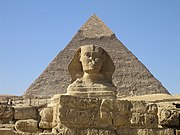
Evidence of human habitation in the Nile Valley since the Paleolithic era appears in the form of artifacts and rock carvings along the Nile terraces and in the desert oases. In the 10th millennium BC, a culture of hunter-gatherers and fishers replaced a grain-grinding culture. Climate changes and/or overgrazing around 8000 BC began to desiccate the pastoral lands of Egypt, forming the Sahara. Early tribal peoples migrated to the Nile River where they developed a settled agriculturaleconomy and more centralized society.[4]
By about 6000 BC, organized agriculture and large building construction had appeared in the Nile Valley[citation needed]. During the Neolithic era, several predynastic cultures developed independently in Upper and Lower Egypt. The Badarian culture and the successor Naqada series are generally regarded as precursors to Dynastic Egyptian civilization. The earliest known Lower Egyptian site, Merimda, predates the Badarian by about seven hundred years. Contemporaneous Lower Egyptian communities coexisted with their southern counterparts for more than two thousand years, remaining somewhat culturally separate, but maintaining frequent contact through trade. The earliest known evidence of Egyptian hieroglyphic inscriptions appeared during the predynastic period on Naqada III pottery vessels, dated to about 3200 BC.[5]
| tAwy ('Two Lands') in hieroglyphs | ||
|
A unified kingdom was founded circa 3150 BC by King Menes, giving rise to a series of dynasties that ruled Egypt for the next three millennia. Egyptians subsequently referred to their unified country as tawy, meaning "two lands", and later kemet (Coptic: kīmi), the "black land", a reference to the fertile black soil deposited by the Nile river. Egyptian culturereligion, arts, language and customs. The first two ruling dynasties of a unified Egypt set the stage for the Old Kingdom period, c.2700−2200 BC., famous for its many pyramids, most notably the Third Dynasty pyramid of Djoser and the Fourth Dynasty Giza Pyramids. flourished during this long period and remained distinctively Egyptian in its

The First Intermediate Period ushered in a time of political upheaval for about 150 years. Stronger Nile floods and stabilization of government, however, brought back renewed prosperity for the country in the Middle Kingdom c. 2040 BC, reaching a peak during the reign of Pharaoh Amenemhat III. A second period of disunity heralded the arrival of the first foreign ruling dynasty in Egypt, that of the Semitic Hyksos. The Hyksos invaders took over much of Lower Egypt around 1650 BC and founded a new capital at Avaris. They were driven out by an Upper Egyptian force led by Ahmose I, who founded the Eighteenth Dynasty and relocated the capital from Memphis to Thebes.The New Kingdom (c.1550−1070 BC) began with the Eighteenth Dynasty, marking the rise of Egypt as an international power that expanded during its greatest extension to an empire as far south as Jebel Barkal in Nubia, and included parts of the Levant in the east. This period is noted for some of the most well-known Pharaohs, including Hatshepsut, Thutmose III, Akhenaten and his wife Nefertiti, Tutankhamun and Ramesses II. The first known self-conscious expression of monotheism came during this period in the form of Atenism. Frequent contacts with other nations brought new ideas to the New Kingdom. The country was later invaded by Libyans, Nubians and Assyrians, but native Egyptians drove them out and regained control of their country.
http://en.wikipedia.org/wiki/Egypt#Art_and_architecture

No comments:
Post a Comment